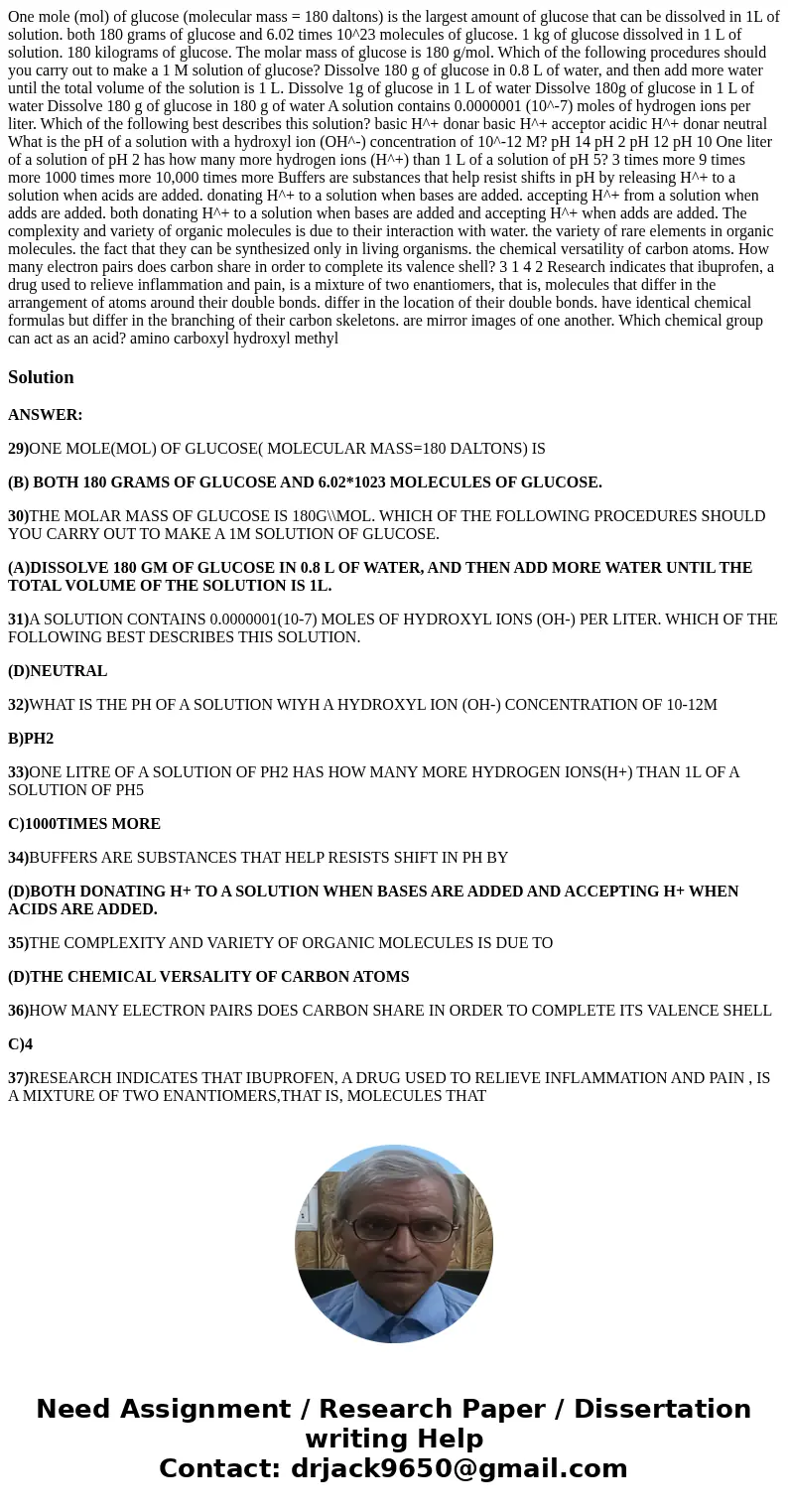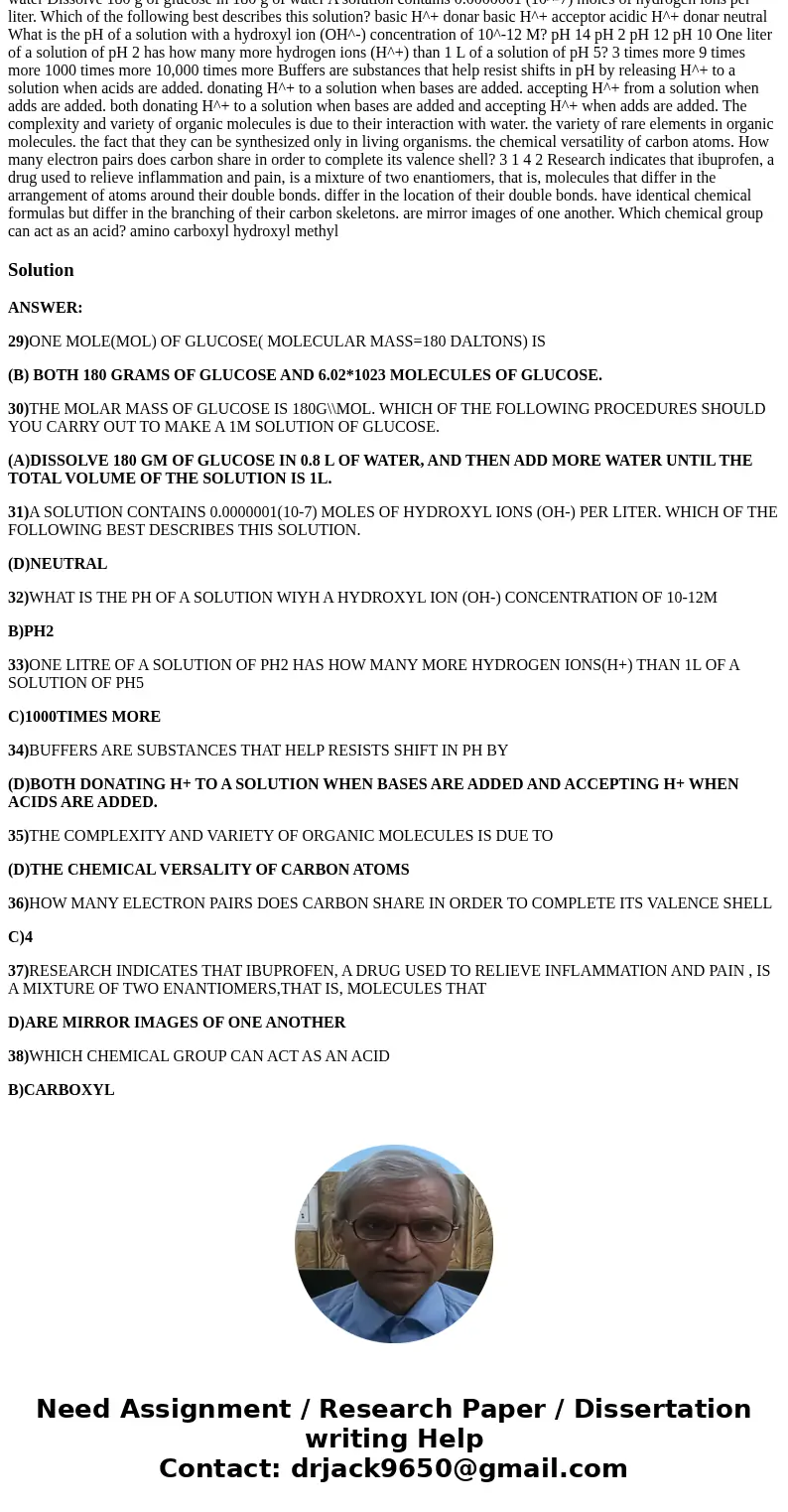One mole (mol) of glucose (molecular mass = 180 daltons) is the largest amount of glucose that can be dissolved in 1L of solution. both 180 grams of glucose and 6.02 times 10^23 molecules of glucose. 1 kg of glucose dissolved in 1 L of solution. 180 kilograms of glucose. The molar mass of glucose is 180 g/mol. Which of the following procedures should you carry out to make a 1 M solution of glucose? Dissolve 180 g of glucose in 0.8 L of water, and then add more water until the total volume of the solution is 1 L. Dissolve 1g of glucose in 1 L of water Dissolve 180g of glucose in 1 L of water Dissolve 180 g of glucose in 180 g of water A solution contains 0.0000001 (10^-7) moles of hydrogen ions per liter. Which of the following best describes this solution? basic H^+ donar basic H^+ acceptor acidic H^+ donar neutral What is the pH of a solution with a hydroxyl ion (OH^-) concentration of 10^-12 M? pH 14 pH 2 pH 12 pH 10 One liter of a solution of pH 2 has how many more hydrogen ions (H^+) than 1 L of a solution of pH 5? 3 times more 9 times more 1000 times more 10,000 times more Buffers are substances that help resist shifts in pH by releasing H^+ to a solution when acids are added. donating H^+ to a solution when bases are added. accepting H^+ from a solution when adds are added. both donating H^+ to a solution when bases are added and accepting H^+ when adds are added. The complexity and variety of organic molecules is due to their interaction with water. the variety of rare elements in organic molecules. the fact that they can be synthesized only in living organisms. the chemical versatility of carbon atoms. How many electron pairs does carbon share in order to complete its valence shell? 3 1 4 2 Research indicates that ibuprofen, a drug used to relieve inflammation and pain, is a mixture of two enantiomers, that is, molecules that differ in the arrangement of atoms around their double bonds. differ in the location of their double bonds. have identical chemical formulas but differ in the branching of their carbon skeletons. are mirror images of one another. Which chemical group can act as an acid? amino carboxyl hydroxyl methyl
ANSWER:
29)ONE MOLE(MOL) OF GLUCOSE( MOLECULAR MASS=180 DALTONS) IS
(B) BOTH 180 GRAMS OF GLUCOSE AND 6.02*1023 MOLECULES OF GLUCOSE.
30)THE MOLAR MASS OF GLUCOSE IS 180G\\MOL. WHICH OF THE FOLLOWING PROCEDURES SHOULD YOU CARRY OUT TO MAKE A 1M SOLUTION OF GLUCOSE.
(A)DISSOLVE 180 GM OF GLUCOSE IN 0.8 L OF WATER, AND THEN ADD MORE WATER UNTIL THE TOTAL VOLUME OF THE SOLUTION IS 1L.
31)A SOLUTION CONTAINS 0.0000001(10-7) MOLES OF HYDROXYL IONS (OH-) PER LITER. WHICH OF THE FOLLOWING BEST DESCRIBES THIS SOLUTION.
(D)NEUTRAL
32)WHAT IS THE PH OF A SOLUTION WIYH A HYDROXYL ION (OH-) CONCENTRATION OF 10-12M
B)PH2
33)ONE LITRE OF A SOLUTION OF PH2 HAS HOW MANY MORE HYDROGEN IONS(H+) THAN 1L OF A SOLUTION OF PH5
C)1000TIMES MORE
34)BUFFERS ARE SUBSTANCES THAT HELP RESISTS SHIFT IN PH BY
(D)BOTH DONATING H+ TO A SOLUTION WHEN BASES ARE ADDED AND ACCEPTING H+ WHEN ACIDS ARE ADDED.
35)THE COMPLEXITY AND VARIETY OF ORGANIC MOLECULES IS DUE TO
(D)THE CHEMICAL VERSALITY OF CARBON ATOMS
36)HOW MANY ELECTRON PAIRS DOES CARBON SHARE IN ORDER TO COMPLETE ITS VALENCE SHELL
C)4
37)RESEARCH INDICATES THAT IBUPROFEN, A DRUG USED TO RELIEVE INFLAMMATION AND PAIN , IS A MIXTURE OF TWO ENANTIOMERS,THAT IS, MOLECULES THAT
D)ARE MIRROR IMAGES OF ONE ANOTHER
38)WHICH CHEMICAL GROUP CAN ACT AS AN ACID
B)CARBOXYL


 Homework Sourse
Homework Sourse